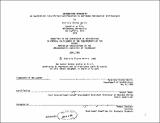| dc.contributor.advisor | Nabeel Hamdi. | en_US |
| dc.contributor.author | Harris, Patricia Elaine | en_US |
| dc.contributor.other | Massachusetts Institute of Technology. Dept. of Architecture. | en_US |
| dc.coverage.spatial | cc----- f------ | en_US |
| dc.date.accessioned | 2005-06-02T13:41:04Z | |
| dc.date.available | 2005-06-02T13:41:04Z | |
| dc.date.copyright | 1986 | en_US |
| dc.date.issued | 1986 | en_US |
| dc.identifier.uri | http://hdl.handle.net/1721.1/17202 | |
| dc.description | Thesis (M. Arch.)--Massachusetts Institute of Technology, Dept. of Architecture, 1986. | en_US |
| dc.description | MICROFICHE COPY AVAILABLE IN ARCHIVES AND ROTCH. | en_US |
| dc.description | Bibliography: p. 177-180. | en_US |
| dc.description.abstract | The purpose of this thesis is to document, through observation and research, architectural elements of a culture that have contributed to the development of another. As such it represents a way of thinking about the impact of architecture on culture and of culture on architecture. The len~ for this focus is the contributions of African people brought to the Caribbean during the European Slave Trade (1520's--1860's). As it essentially was a world region where the influence of indigenous people was negligible due to their early demise and general lack of an extensively developed architecture, it may almost be regarded as a 'clean slate' upon which the Europeans and Africans devised an architecture based on climate, materials, and tradition modified by colonization/enslavement. As climate and materials were generally similar to those found in Africa, tradition may be considered the most important aspect of this process and is the basis for this thesis and for the exploration of the following questions: What did Africans do to contribute to the architecture of the Caribbean; how did they say, "We are here?" What may have been present in the physical landscape, built and natural, that gave Africans brought to the New World any sense of familiarity of place in an otherwise alien environment? What are some of their contributions that have survived, either through transferal or transformation, physically tangible or attitudinal, that are present in the Caribbean today? In general, what do people do to affect the physical environment when they are in positions of social and economic powerlessness? | en_US |
| dc.description.statementofresponsibility | by Patricia Elaine Harris. | en_US |
| dc.format.extent | 183 p. | en_US |
| dc.format.extent | 10247703 bytes | |
| dc.format.extent | 10272698 bytes | |
| dc.format.mimetype | application/pdf | |
| dc.format.mimetype | application/pdf | |
| dc.language.iso | eng | en_US |
| dc.publisher | Massachusetts Institute of Technology | en_US |
| dc.rights | M.I.T. theses are protected by copyright. They may be viewed from this source for any purpose, but reproduction or distribution in any format is prohibited without written permission. See provided URL for inquiries about permission. | en_US |
| dc.rights.uri | http://dspace.mit.edu/handle/1721.1/7582 | |
| dc.subject | Architecture. | en_US |
| dc.title | Celebrating diversity : an exploration into African contributions to Caribbean residential architecture | en_US |
| dc.title.alternative | Exploration into African contributions to Caribbean residential architecture | en_US |
| dc.type | Thesis | en_US |
| dc.description.degree | M.Arch. | en_US |
| dc.contributor.department | Massachusetts Institute of Technology. Department of Architecture | |
| dc.identifier.oclc | 15463845 | en_US |
